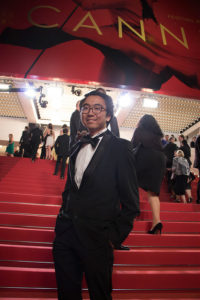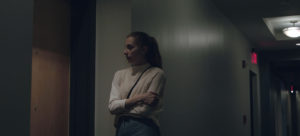Showcase Filmmaker Spotlight: Alex Atienza
Showcase Filmmaker Spotlight: Alex Atienza
By Travis Trew, Programming Associate
 Maryland native Alexander Atienza recently graduated from the University of Pennsylvania, where he majored in cognitive science and philosophy and minored in linguistics and consumer psychology. Somehow, Atienza also found time to pursue his passion for filmmaking as an undergrad, writing and directing several shorts. Vivisection Mambo: or Mating Strategies in the Year 3000 is an unsettling psychological thriller about an insomniac whose forays into ASMR-induced therapy have some unintended side effects.
Maryland native Alexander Atienza recently graduated from the University of Pennsylvania, where he majored in cognitive science and philosophy and minored in linguistics and consumer psychology. Somehow, Atienza also found time to pursue his passion for filmmaking as an undergrad, writing and directing several shorts. Vivisection Mambo: or Mating Strategies in the Year 3000 is an unsettling psychological thriller about an insomniac whose forays into ASMR-induced therapy have some unintended side effects.
PFS: How did you get interested in filmmaking?
AA: I think it probably started in high school. Actually it sort of started with me being interested in subliminal messaging in Stanley Kubrick films. Directing became a natural extension of my existing interests in photography and creative writing, which I also did in high school. I guess one of the reasons I was more interested in directing rather than screenwriting or cinematography was that I was a lot more interested in style. I found myself more at home synthesizing the various aspects of production, and what draws me to a movie even more than the story is the mood. For me, mood is paramount. I really think it can make or break the film. I feel that a director’s job is to use that advantage to bring the creative components together and convey that to a viewer.
PFS: You didn’t actually study film in college, but still found time to make films on top of your class work and extracurriculars. Was that tough?
AA: Yeah, it definitely was. I actually found myself secretly jealous of my friends who were in the cinema studies program because they frequently could take classes that would afford them the ability to spend a lot of time working on these projects. But I think a lot of the reason I was interested in cognitive science and philosophy was that studying something other than film would give me ideas that would then provide me with inspiration for the stories that I would eventually want to tell.
PFS: You can certainly see some of the influence of cognitive science and psychology in Vivisection Mambo. How do you think studying those subjects affects the stories you tell?
AA: That’s a big question. One of the reasons I became interested in cognitive science is the psychology of art. The reason I became interested in psychology of art is through film theory. A lot of film theorists borrow from linguistics regarding how humans try to decode information and then they apply it to the language of sequences of images. That’s something I consciously keep in mind when I’m trying to tell a story visually.
PFS: What was the inspiration for Vivisection Mambo?
AA: I was looking to apply to MFA filmmaking programs, many of them require a portfolio and I wasn’t confident with the quality of my existing work. I really wanted to make something that was conceptually ambitious. But the idea for it came a lot earlier. Before Vivisection Mambo, my cinematographer had shot a short with the same actors you see in my film. I didn’t know what the short was about at that time, but he shared some stills from the film and the music he had chosen with me, which lead me to speculate on what the film he was making was about. I speculated that the plot included mind control, but I read the script and realized I was wrong so I recycled my failed prediction into an original screenplay.

PFS: The ASMR aspect is interesting. What about that subject struck you?
AA: Because of budget constraints, it was something that I could explore without having to create very elaborate special effects. All I needed was a voice over—a creepy voice over—to go over the shots. I think it’s fascinating how large a community has developed around ASMR online. That was something that was very alien to me. I wanted to incorporate some of the anthropological curiosity that had piqued my interest into the script. I also grew up reading a lot of Wikipedia articles about unsolved mysteries. The allure is that they’re not stories in the traditional sense, with a beginning, middle, and end. I wanted to reflect that in the script. Also I wanted to avoid anything supernatural. That limit was because of special effects but also an aesthetic choice, because I feel like ghosts or aliens come with a lot of cultural baggage and connotations that are hard to get rid of. When developing ideas for a premise, I intentionally tried to avoid things like that.
PFS: You had also mentioned Kubrick earlier, but were there any other reference points for this film?
AA: Some of the specific directors I had in mind were Panos Cosmatos, who did Beyond the Black Rainbow, and Rick Alverson, whose film Entertainment actually screened at the Philadelphia Film Festival a couple years ago. The films Upstream Color and Under the Skin also influenced the tone and mood.
PFS: You mentioned that for you mood can be as important, if not more important, than story. How did you imagine the mood? And then how did you go about achieving it?
AA: I hadn’t really made a psychological thriller like this and I really wanted to expand my tonal language. I also just think horror and thrillers are really fun to direct. When I try to direct something like a horror film or a thriller, I pay more attention to the response of the viewer because it’s designed to elicit a really specific emotion, So I’m paying a lot more attention to the lighting, for instance. I heard an interview with Alfonso Cuarón where he said that if you look at comedies, for example, not as much attention is paid to the lighting as with drama or horror. Which is strange because there shouldn’t really be that discrepancy. I think that more or less exemplifies the kind of attention that’s paid to the response of the viewer with horror and thrillers.
PFS: The full title is Vivisection Mambo: Or Mating Strategies in the Year 3000. Where did that come from?
AA: It’s actually a combination of two separate titles that I came up with originally. The first came about from something that was autocorrected as I was typing on my phone. I found it so deliciously macabre, this unlikely combination of words. It’s almost like a “Dance of Death.” And I think the latter half was unconsciously channeling the film The Lobster. I think combining them together had this maximalist vibe to it, almost like Dr. Strangelove, or Birdman, or Slaughterhouse-Five, which have these really long titles.
PFS: The role of the mysterious cube is left pretty ambiguous. How did you sort of land on that particular object?
AA: There’s actually a short story by Borges about someone who found an object that causes anyone who comes in contact with it to develop a really intense obsession with it. And I found that to be very fascinating. I liked the aura that’s given to it but really the cube is just a MacGuffin.
Vivisection Mambo: or Mating Strategies in the Year 3000 will screen on Friday, March 9 at the Prince Theater’s Black Box as part of Philly Film Showcase, an exhibition supporting new work by talented, up-and-coming local filmmakers.